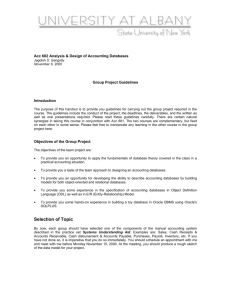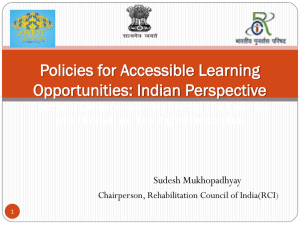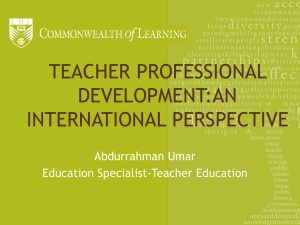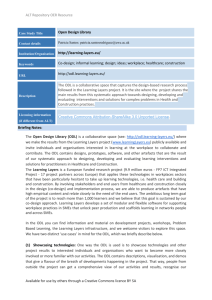The Millennium Development Goals: a cross
advertisement
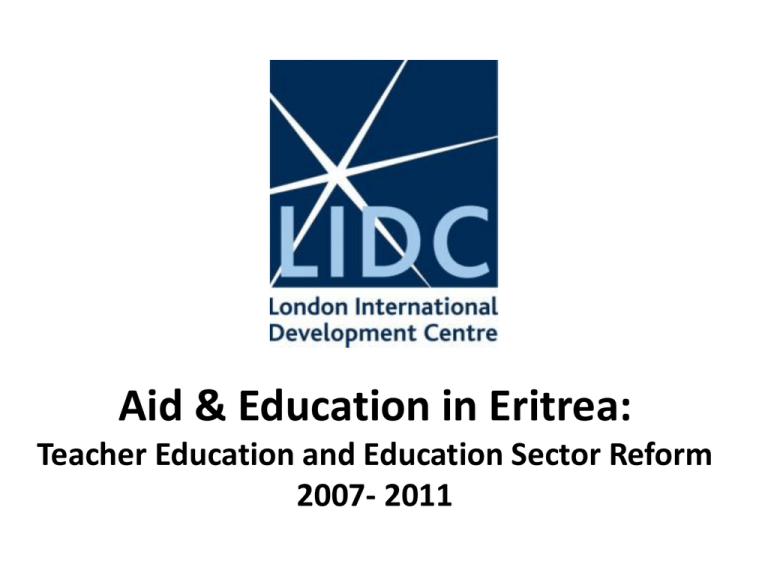
Aid & Education in Eritrea: Teacher Education and Education Sector Reform 2007- 2011 1. Eritrea: regional geography & population Population: 5,291,370 (2008 Census) Main Languages: Tigrinya, Arabic, English, Italian Ethnic groups: 9, inc. Tigrinya, Tigre, Saho, Afar, Kunama. GDP per capita: $397 2. Eritrea: history & politics Ancient history: C.25th BC: Land of Punt; C. 8th – 5th BC: Kingdom of D’mt; C. 1st BC – 940 AD: Aksumite Empire Middle history: C. 10th – C.18th: Trading links with and partial colonisation by Egypt; Yemen; Portuguese Goa; Ottoman Empire; British Empire Modern history: 1890 – 1941:Italian colony (following Italian invasion in 1870s) 1941 – 1951:British administration 1951: Federated with Ethiopia, under US-led UN resolution 1961 – 1991: Insurgency against Ethiopian Government 1993: UN recognition of Eritrean independence 1998: Eritrean-Ethiopian War Present: On-going border dispute with Ethiopia; A one-party state governed by People’s Front for Democracy & Justice; President: Isaisas Aferwerki 3. Eritrea: national geography & population No. Zoba Pop. 1 Ma’akel 538,749 2 3 4 Debub Gash-Barka Anseba 755,379 564,574 457,078 5 Northern Red Sea 459,056 6 Southern Red Sea 203,618 4. Eritrea: basic education system Primary Education (Grades 1 – 5) •Enrolments: 286,111 (approx. 52% of primary-age population) •Completion Rate: 51% •School Teachers: 7,507 (83% qualified Cert level) •Pupil > Teacher Ratio: 45:1 Middle and Secondary Education (Grades 6 – 12) •Enrolments: 247,431 (approx. 23% of middle/secondary-age population) •Completion Rate: 51% •School Teachers: 6,326 (92% qualified Dip. level) •Pupil > Teacher Ratio: 52:1 5. Eritrea: basic education system Zoba PSs Sts Ts MSs Sts Ts SSs Sts Ts 1 Ma’akel 104 61833 1784 46 42174 1126 21 29637 883 2 Debub 236 94987 2255 85 56369 1242 26 27685 648 3 Gash-Barka 200 57209 1467 61 21277 517 13 8125 272 4 Anseba 126 42893 1186 52 2271 503 12 8922 269 40 10057 283 10 5257 185 5 N. Red Sea 99 24799 644 6 S. Red Sea 35 TOTAL 4390 171 9 1963 69 800 286111 7507 293 151911 3740 2 1173 42 85 95520 2586 6. Eritrea: tertiary and teacher education University of Asmara: •College of Marine Biology (Masawa) •College of Agriculture (Debub) •College of Arts and Social Sciences (Keren) •College of Business and Economics (Mendefara) •College of Nursing and Health Technology (Asmara) The Eritrean Institute of Technology (EIT), Asmara •College of Education: MA, BA and Diploma of Education (for middle + secondary teachers) Asmara Teacher Education Institute (ATEI), Asmara •Certificate of Education (for primary teachers) Ministry of Education: HRD dept & Zoba Education Offices •In-service training of teachers 7. The Eritrean Education Sector Development Programme 2007 - 2011 •EU-funded: Eu52million •Operated alongside projects from World Bank and UNICEF Main strands of activity: • • • • • • • Capacity building to implement ODL for teacher education; Policies and strategies for TVET; Revise national curriculum; Design of materials for English; Develop educational monitoring and QA system; Develop comprehensive accreditation and evaluation system; In addition: a significant school-building programme. 8. ESDP: Teacher Education inputs Outputs: • EIT’s ODL Middle School Teacher Upgrading Programme (MSTUP) • ATEI’s Self-study Elementary Teacher Upgrading Programme Inputs A: capacity-building activities: • ODL management and admin training for MoE, Zoba and EIT/ATEI staff • ODL materials design training for EIT / ATEI staff • training of tutors, sub-Zoba support staff etc. Inputs B: programme design activities: • Financial management; • Admin and delivery systems; • Institutional roles • Content and materials design • Assessment systems etc. 9. ESDP: Teacher Education ODL programmes • EIT’s ODL Middle School Teacher Upgrading Programme (MSTUP) • ATEI’s Self-study Elementary Teacher Upgrading Programme Basic design model: • 2 years in-service study • Blended learning: self-study materials plus local tutorial sessions & residential summer school • Assessment : written assignments; classroom observation; end-of-year exams Basic delivery model: • EIT / ATEI: materials design & distribution; examinations; awards • Zoba Offices: tutor recruitment; learner support; sub-Zoba co-ordination; assignment collection • MoE Dept of HRD: finances; monitoring; liaison 10. ESDP: Teacher Education ODL programmes Design issues: • Skepticism about ODL • Emphasis on academic rather than practitioner content (esp. EIT) • Preference for high face-to-face contact Delivery issues: • EIT / ATEI: low institutional capacity for undertaking field activities • Zoba Offices: low institutional capacity for sub-Zoba activities • Unclear lines of communication and authority between stakeholders • Low levels of training and support for sub-Zoba staff (tutors; schools) • Schedule delays not always passed to learners and tutors • Irregular monitoring and follow-up by stakeholders • Regional disparity in terms of access to resources, travel time & costs 11. ESDP: ODL programme outcomes Successes: • Good final pass rates (85% on both programmes) • High levels of student satisfaction with materials and content • Establishment of basic national frameworks for ODL delivery in education • Enhanced understanding and capacity in ODL practice across all national stakeholders Necessary improvements: • Low levels of student satisfaction with learner support and communications • Improve communications between central stakeholders • Address resourcing issues for stakeholders undertaking field activities • Improve programme engagement at sub-Zoba level • Identify potential for de-centralised initiatives to address local needs chris.joynes@lidc.bloomsbury.ac.uk
